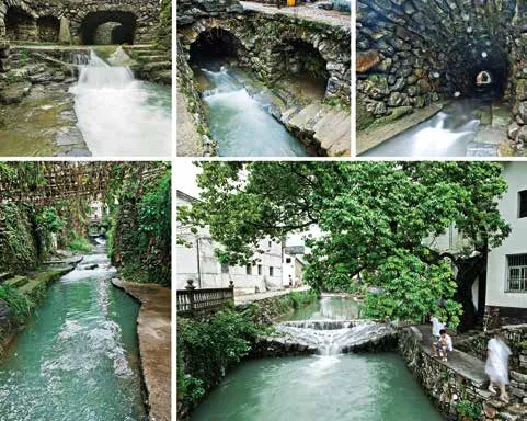Songxi's Cultural Character
2016-10-27ByFuShuqing
By Fu Shuqing
Songxi's Cultural Character
By Fu Shuqing

明溪(下)与暗溪 (傅忠生 摄)Streams in Songxi Village
Situated in northeastern Pujiang, Cockscomb Rock is famed as the “number one peak in Pujiang” for its precipitousness. The natural beauty of this mountainous area, in which the village is sited, forms the “top 10 scenic attractions” of the village that is named after a babbling stream.
The written history of Songxi Village dates back to the Shaoxing years of the Southern Song Dynasty (1127-1279). During his tenure in Jiangsu and Zhejiang provinces, Military Commissioner Xu Binli was so enchanted by the cultural mellowness of Pujiang that he settled down in today's Wujiangshan. Later, a government official known as Xu Jin brought his family to the scenic area around the Songxi River and settled down after the fnishing of his tenure in Zhuji. The Xu family was joined by many others moving into the idyllic settlement. Throughout the village's thousand-yearlong history, the village has maintained a community harmony.

每年元宵节,嵩溪村都有舞板凳龙的习俗。 (楼建镇 摄)Songxi Village stages a bench dragon dance during Lantern Festival every year.
A tangible illustration of the village's fne tradition of respecting culture and morality is the local architecture and people's consensus about architectural conservation. Boasting an old architectural sprawl that contains as many as 1,560 houses that are all in good condition, the village is justifiably an architectural trove in Zhejiang. However, the fact is that the village suffered from devastating fire three times in the years of Emperor Jiaqing and Emperor Xianfeng of the Qing Dynasty and in the World War Two when Chinese people were fghting Japanese invaders.
Two biggest highlights of the historic buildings in the village are the ancestral hall of the Xu family, built in 1696 in the years of Emperor Kangxi of the Qing Dynasty, and the ancestral hall of the Shao family, erected in 1714, both recognized masterpieces of traditional Chinese architectural aesthetics.
The murmuring Songxi stream is the lifeline of the village. It is believed by the locals that the current waterway network is a remake from three brooks for the consideration of the Chinese “Fengshui”.
In Songxi, the unwritten rule of fetching water for domestic use from fve designated exits only and at different times of a day has been followed strictly by the entire village population for hundreds of years. The water fetched in the morning is used for rinsing vegetables and rice. The afternoon hours are for laundry and watering crops. The night water is used for bathing only. The implications of such a rigorous way of water usage are enormous, suggesting the village wisdom and outstanding vision.
The modern heyday of the village was ushered in by the start of China's openup and reform in 1978. In the late 1970s and throughout the 1980s, many villagers earned their frst pot of gold in the village's“limestone rush”. The economic boom brought a new look to the village, hence the village's reputation as “Little Hangzhou”.
The village's charisma also springs from the high cultural attainment of the locals. Songxi is famed for its large farmer poet community that has been a major player in the poem literature of Pujiang (dubbed China's “capital of poetry”) and an outstanding participator in the annual Farmer Poets Festival. The poem-writing tradition of Songxi is believed by many as dating back in the early years of the Ming Dynasty(1368-1644). The village is proud to have a 300-year-old Poem Society, established by Xu Jingchen in the years of Emperor Kangxi of the Qing Dynasty and remaining active to this day. It is the oldest and only village-level poem society in Zhejiang and one of the few of its kind in China.
